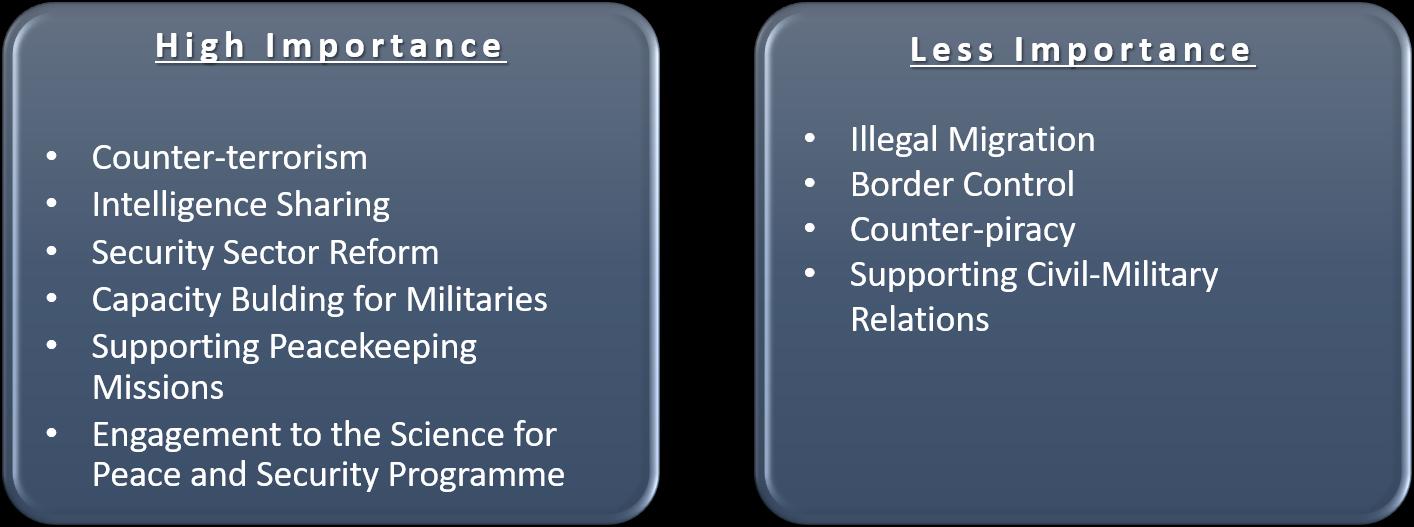
4 minute read
b. Methodology
- What would be the priorities for African countries in its relations with NATO?
b. Methodology
The Delphi technique has primarily been utilized to analyze current issues and their potential solutions in the future. The method was developed by Olof Helmer, Nicholas Rescher, Norman Delkoy and others in 195912 and the first paper using Delphi Research was published in 1964, entitled “Report on a Longrange Forecast.”13 Essentially, the Delphi Method allows researchers to analyze and forecast with high levels of accountability and reliability.
The technique first identifies the experts to be included into the research; later it implements at least two rounds of survey, and if needed it is possible to execute subsequent rounds. In the first round, which uses open ended questions, experts articulate themselves independently on a specific subject and reflect their expertise on a specific issue without any reservations. At the conclusion of first round, the researcher should then develop a second round of surveys, or interviews, based on the first-round responses. In the second round, a multiple-choice questionnaire is deemed to be preferable. The rounds can be in person or online but should not take the form of an open discussion amongst the experts, who instead remain separate.
The reasoning behind the decision to keep the experts isolated from one another in their responses is the asserted belief that open discussion between experts would potentially mean that the researcher loses her/his control of the process and the responses, so instead the method aims to prevent such biases. The key for success of the method is based on the initial expert selection. The Delphi technique is not a statistical method to produce a universal, fully representative sample. Instead, it is about the expertise of the limited group of responders. If it were a statistical method, the researcher would have needed a proper representative sample of those who are engaged in the subject or area. However, in Delphi technique, this is not necessary, because the technique allows the researcher to benefit from the experts ’knowledge on the specific subject. As a result, the selection of experts, the degree of their expertise for the research, the amount of the responders as well as their acceptance rate matters. Generally speaking, 15 to 35 people as respondents is desirable, with the invitation acceptance rate of between 40 and 75 per cent being considered satisfactory.14
The disadvantage of this method is that it takes time to implement regarding the aforementioned multiple rounds of surveys with experts. One should recognize that the Delphi technique is not presenting an accurate forecast, yet it has a capacity to present instead an educated assessment on the future of a specific subject.
Essentially, in the case of this research activity the Delphi technique has been applied in two rounds. In the first round a structured, open-ended essay-style survey was distributed to the selected experts drawn from throughout the South and, after analysis of the first round, a second survey was prepared
12 Helmer, Olaf and Rescher, Nicholas, “On the Epistemology of the Inexact Sciences,” Management Sciences, Vol. 6, No.1, 1959. 13 Gordon, T.J., and Helmer, Olaf, Report on a Long-Range Forecasting Study, RAND Corp., R-2982, 1964. 14 Gordon, T.J., “The Delphi Method,” Futures Research Methodology, Vol.2, Issue.3, 1994, p. 7 (pp.1-30)
and distributed to the first-round responders based on the answers given during the first round. The two-round-approach allowed the researcher to share different perspectives and propositions with all the experts. During the second round of analysis, which was multiple choice, it was possible to reach an educated opinion on the expectations and demands of NATO from the African side. (Figure 2)
Figure 2: The Processes of the Delphi Method for the Africa Research
Preparation

Implementation
Evaluation
•Describing the Research Questions •Identify Potential Experts •Select Experts
•Preparation the 1st round Survey •Sending the questionnaire •Assessing the 1st round of survey •Preparing the 2nd round survey •Sending the 2nd round survey
•Analyzing the results •Writing the preliminary report •Discussing the preliminary report •Tuning the report to publish
After developing the research questions, the qualifications of the likely experts were confirmed. The criteria for the selection of the experts were based on their professional background, such as PhD. candidate in security studies, security experts, academics, senior practitioners, diplomats and military/security sector employees. Essentially, the goal was to reach out to experts whose area of expertise was focused on all or as much as possible of the African continent. The main goal was to reach at least 25 responders. In order to reach experts, personal networks, Linkedin.com, Academia.edu, Google Scholar and the related web sites of academic and international institutions were used. 66 invitations were sent on the first round and 31 experts responded. In the second round, 27 out of 31 experts responded. (Figure 3 and Figure 4)
Figure 3: The Distribution of professions of the Experts
PhD Candidate
6

Practitioner
2
Analyst (Politics)
5
Analyst (International Security) 11

Academic
4
Diplomat
3
TOTAL 31

The first round of the open-ended survey was sent in July 2021 and the second round, the multiple choice survey, was sent to the first-round responders in mid-August of the same year. In September the responses for the second-round survey were collected. Regarding the scope of the experts, their level of expertise and their responses, the implementation of the Delphi technique proved to accountable and reliable to a high degree. However, as a stated limitation of the research, the assumption that North Africa, as a distinctly different region, would differ from the rest of the continent proved correct.
Figure 4: Distribution Map for Coverage of the Experts’ expertise in the research






